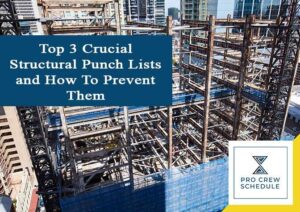In general, construction can use various methodologies and forms in delivering the intended final product of a project. It is not uncommon for a general contractor to split the scope of works into different phases to achieve the project milestones. In this case, a general contractor often hires various subcontractors or trade contractors to handle individual work packages according to their specialty. However, it is still the main contractor responsible for managing construction work quality and the coordination of the subcontractor’s activities.
Maintaining quality while handling a lot of manpower from different groups can be very hard. Almost every time in any project, the group of workers outnumbers the group of engineers by a large sum. With these, how can we ensure the best quality of work throughout the whole construction process? The answer is through optimizing the use of punch listing.
A punch list can be considered as a summary of tasks and items that need to be fixed or completed before a construction activity can be considered finished. Creating and completing an accurate punch list can prove to be essential in delivering a successful project. To ensure the best review process, all parties involved within the construction can conduct a walkthrough within the whole project altogether.
In today’s blog, we will discuss some of the most common punch lists that we should watch out for, specifically during the structural phase, which is the most critical in the project lifecycle in construction.
Structural Honeycomb
Honeycombs can be defined as rough, eroded surfaces or voids on concrete structures resulting from incomplete filling of the concrete within the formworks during casting. What makes honeycombs on concrete dangerous is that the voids reduce the structure’s cross-sectional area, and we know that this area is directly proportional to the concrete structure’s compressive strength. If large enough, the voids can also be a pathway for water to flow inside the structure, which will result in the corrosion of the reinforcing bars.
This type of malpractices needs rectification as soon as the punch list was discovered because it is not aesthetically pleasing for the eyes; it also displays the quality and construction crew management skills of an engineer. Causes of honeycombs include the following reasons:
1. Decreased workability of the concrete
The workability of the concrete determines its ability to flow during casting. It is often decreased when the concrete is approaching or, worse, already past its setting time. It can also result from the decrease in the water content of the mix; that is why concrete casting is often done during the night; to prevent the heat of the sun from drying the concrete mix faster and making it stiff. This shows that it is important to always conduct a slump test for every concrete mixer truck, before and even during their respective concrete mix.
2. Ineffective vibration of concrete during casting
The most common and also the simplest cause of honeycomb. This occurs when not all workers on site devote their whole effort to the task. This is evident when concrete casting will be done at night until early morning; most workers skip essential construction steps, such as merely vibrating the concrete to fill every corner and space. Such practices can be avoided with proper management for construction and monitoring of the site engineer. Other reasons can also be factors such as a considerable increase in water content of the concrete mix; this will result in a reduction of the volume of cement and aggregates due to the rise in the volume of water.
3. Holes or gaps in the formworks
Traditional formworks like phenolic boards can usually be reused for a minimum of six (6) times for concrete casting; this practice of some contractors decreases the total estimated budget allocated for the number of formworks to be used by a large margin. Reusing phenolic boards causes damages and holes on the formwork, especially when it is used for a different structure or area from the previous casting. These holes and gaps will serve as pathways for the concrete mix to flow through, thus reducing the volume of concrete mix that was supposed to fill the formworks, which will result in voids or pitted surface of the structure.
4. Insufficient clear space for aggregates
Laying out of reinforcing bars and sometimes conduits too close with each other makes it hard or nearly impossible for the aggregates of concrete to pass through during pouring. This will result in empty spaces or voids specifically for those areas.
Rectifying honeycombs usually involves the following steps:
- Chipping of loosened parts and aggregate of the structure;
- Cleaning and washing the affected area;
- Drying and applying approved structural epoxy or grout;
- Pouring or pasting of the approved concrete mix on the area where the honeycomb occurred;
- Finishing and curing of the repaired area.
Concrete Woodchips and Sawdust
Although we encounter in some articles that sawdust can be used as a replacement to sand as fine aggregates of concrete, having these substances in the mix during casting would cause problems that can be expensive to fix depending on the severity. Sawdust is waste products from woodworking operations such as sawing or sanding, especially when using phenolic boards. Even if we try to mix them mechanically or by hand, these materials are not cementitious and do not have the ability to bind with concrete.
This punch list can usually be found on beams or, worse, on columns. Aside from sawdust occupying spaces that were supposed to be filled with concrete, which reduces the cross-sectional area just like on honeycombs, it can sometimes be severe to connect a column between its lifts.
Having sawdust or other unwanted materials stuck or staining a structure can be minimized just by merely ensuring that the place where the concrete would be cast clean before pouring. This can be done by providing cleanouts where these waste products will pass through during cleaning. Cleanouts are provided usually on columns since materials tend to go to lower spaces when being pushed away by air or water.
Rectification of this punch list is almost similar to rectifying honeycombs and usually involves the following steps:
- Thoroughly brushing or removing sawdust or other unwanted material on the structure;
- Chipping any loosened parts of the structure;
- Washing then drying of the affected area;
- Applying approved structural epoxy or grout;
- Pasting the approved concrete mix or mortar on the area.
Missing Trimmer Bars for Openings and Pipe Chase
Installation of trimmer bars for all openings such as doors, windows, or pipe sleeves, is a structural detail commonly skipped by some contractors, especially for residential projects where the owner is not that knowledgeable regarding construction and does not have the financial capability of hiring a structural engineer. Trimmer bars are reinforcing bars placed tangential to the edges of structural openings, where the shear stress is high, to prevent cracks. Cracks are dangerous if it is evident on both sides of a structure (top and bottom; interior and exterior).
Not installing trimmer bars for openings or block-outs on the slab is worse because, depending on the finish or the severity of the cracks, the rectification requires injecting of structural epoxy for the whole span of the cracks. This method requires a large budget and is usually calculated per linear meter of the crack. If not rectified, these cracks will be passageways for water to seep through, risking the reinforcing bars of a structure to be subjected to corrosion. For slabs, water seeping through cracks can damage ongoing or finished architectural works such as ceiling installation or painting.
Other Common Structural Punch Lists
- Plumbness and alignment of formworks;
- Proper reinforcement bar diameter and number;
- Improper location of Construction Joint;
- Insufficient concrete cover and overlap for steel reinforcements;
- Wrong floor finish and reference level for slabs.
All items included in the previous list can be minimized or completely avoided by studying construction drawings and thorough inspection before or even during concrete casting.
Prevention Is Better Than Rectification
Almost, if not all, every contractor aims to have zero punch list construction as their goal. Having a list of such practices makes all parties aware that the engineers and the project management team prioritize quality above everything else. This will result in less repetition of the punch list, resulting in less rework and more profit for a project. This will also result in better coordination within the whole construction team, followed by good documentation and communication.
Construction is never perfect; there will always be discrepancies and errors with the drawings and the actual site condition. Lapses in decision making and the execution of the procedures themselves are also inevitable, especially with many manpower exerting different levels of effort for the project. However, wrong practices can be minimized if the engineer tasked to monitor a specific site activity knows the basic procedures and will not just rely on the workers to finish the job. The quality of a project does not depend solely on the Quality Control Engineer or Quality Management Team— it is also the responsibility of Project Manager down to Project/Site Engineer to maintain the quality, for it will always reflect in the output of the project.







